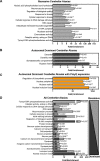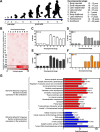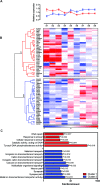Integrative network and brain expression analysis reveals mechanistic modules in ataxia
- PMID: 30591515
- PMCID: PMC6581079
- DOI: 10.1136/jmedgenet-2018-105703
Integrative network and brain expression analysis reveals mechanistic modules in ataxia
Abstract
Background: Genetic forms of ataxia are a heterogenous group of degenerative diseases of the cerebellum. Many causative genes have been identified. We aimed to systematically investigate these genes to better understand ataxia pathophysiology.
Methods: A manually curated catalogue of 71 genes involved in disorders with progressive ataxias as a major clinical feature was subjected to an integrated gene ontology, protein network and brain gene expression profiling analysis.
Results: We found that genes mutated in ataxias operate in networks with significantly enriched protein connectivity, demonstrating coherence on a global level, independent of inheritance mode. Moreover, elevated expression specifically in the cerebellum predisposes to ataxia. Genes expressed in this pattern are significantly over-represented among genes mutated in ataxia and are enriched for ion homeostasis/synaptic functions. The majority of genes mutated in ataxia, however, does not show elevated cerebellar expression that could account for region-specific degeneration. For these, we identified defective cellular stress responses as a major common biological theme, suggesting that the defence pathways against stress are more critical to maintain cerebellar integrity than integrity of other brain regions. Approximately half of the genes mutated in ataxia, mostly part of the stress module, show higher expression at embryonic stages, which argues for a developmental predisposition.
Conclusion: Genetic defects in ataxia predominantly affect neuronal homeostasis, to which the cerebellum appears to be excessively susceptible. Based on the identified modules, it is conceivable to propose common therapeutic interventions that target deregulated calcium and reactive oxygen species levels, or mechanisms that can decrease the harmful downstream effects of these deleterious insults.
Keywords: molecular genetics; movement disorders (other than parkinsons); neurology.
© Author(s) (or their employer(s)) 2019. Re-use permitted under CC BY-NC. No commercial re-use. See rights and permissions. Published by BMJ.
Conflict of interest statement
Competing interests: None declared.
Figures





References
Publication types
MeSH terms
LinkOut - more resources
Full Text Sources
